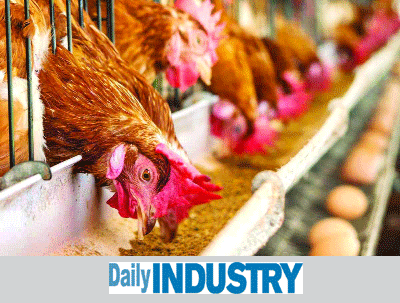Bangladesh facing 35pc shortage in meat-egg
Mahfuja Mukul:Bangladesh still has been facing 35 percent shortage in meat, egg and poultry products. The sector has created employment opportunity for 6 million people but still having huge scope to create job opportunity. The poultry sector of the country has potentials to export the processed products in different international markets.
Morethan half of the population is based on agricultural and livestock farming in the country. The poultry sector is an integral part of farming systems and has created both direct and indirect employment opportunity, improved food security and enhanced supply of quality protein to people’s meals, contributing country’s economic growth and reducing poverty level in rural and urban areas.
The present meat and egg production can mitigate only 65 percent of the national demand. The demand for meat, egg and meat and egg products have been expanding dramatically with income growth, population growth, urbanization and dietary changes.
Recognizing this fact, the government and the private sector are working together to solve the problem in poultry industry through various development activities. Apart from this, government is encouraging private sectors and NGOs to undertake steps for the development of poultry by liberalizing its present policy.
Poultry
The poultry sub-sector is an important avenue in fostering agricultural growth and reduce malnutrition for the people in Bangladesh1. It is an integral part of farming system and has created direct, indirect employment opportunity including support services for about 6 million people.
This sub-sector has proved as an attractive economic activity, thereby, indicating its importance for the entire economy. The sector accounts for 14 percent of the total value of livestock output and is growing rapidly. It is found out that poultry meat alone contributes 37 percent of the total meat production in Bangladesh.
Poultry contributes about 22-27 percent of the total animal protein supply in the country. It is stated that in Asia, poultry manure is used as feed for fish where poultry are raised on top of the ponds as part of an integrated system for example, fish-cum-duck farming. Development of poultry has generated considerable employment through the production and marketing of poultry and poultry products in Bangladesh.
The total number of poultry farms in the country is 150,000 excluding 2 duck farms. In addition to that, there are 6 poultry and 2 duck hatcheries are operated in the public sector.
It is stated that, the performance of poultry production depends on the type of genetic resources, feeding practices, the prevalence of diseases, prevention and control, the management of flocks and the interactions among these factors.
The progress of poultry industry in Bangladesh is mainly in private sector. In the early 90s, a number of private parent stock poultry farms started their operations to produce commercial broiler and layer day old chicks. During 1970-80, the poultry population growth rate was 0.7 percent which increased to 4 percent per year during 1990-2020.
According to the national health strategy, an adult people need 120 g of meat every day and 104 pieces of eggs per year. However, presently the availability is only 67.17 and 63.65 percent, respectively.
Although meat production has been increasing over time in the country but the per capita availability is far below the minimum requirement. Recently, the demand for poultry and livestock products, in general has been increased significantly that leads most to poultry-related development interventions promoting intensification of traditional poultry systems.
The government is getting interested in this sector and is encouraging both urban and rural people to work here and enhance capacity. People in rural areas are getting attracted to this sector and taking it up as a business. Besides government, there are many private enterprises, like Aftab Poultry, Aman Poultry, Bangladesh Rural Advancement Committee (BRAC), C.P. (Bangladesh) Co., Ltd., Kazi Poultry, Nourish Poultry, Paragon Poultry etc. are working for poultry and poultry products development in the country. Moreover, good management practices should improve for the development of poultry industry. Experiences from South Asian countries show that adoption of good practices of poultry management can significantly contribute to an improvement of farmer’s livelihoods.
Contribution of livestock and poultry in Bangladesh economy
Livestock and poultry have been playing an important role in the national economy, contributing significantly to agriculture and the gross national product. About 44 percent of human daily intake of animal protein comes from livestock products. Furthermore, it plays a pivotal role in the rural socio-economic system as maximum households directly involved in livestock.
It has created job opportunity for more than 6 million people. The poultry industry has been engaging supply of quality protein to the Bangladesh population at the lowest price in the world.
In the 90s total investment in this sector was only Tk 15 thousand million, but now it is more than Tk 150 thousand million. Investment in poultry sector should be doubled within the next decade and it will enhance the growth of this sector and contribute in the GDP and creates employment opportunity.
Population and growth of poultry in Bangladesh:
Poultry population in Bangladesh is estimated about 304.17 million where chicken population is about 255.31 million and duck population is about 48.86. The growth rate of chicken and duck for last 10 years was 3.75 and 3.05% respectively. Growth rate of poultry was about 6.21% during 2004-2007 but growth rate declined (2.70%) during the financial year 2007-08 due to incidence of bird flu (avian influenza). This situation improved during 2019-20 (4.20%) and again declined since 2019-20 about 2.89%.
Present demand and supply of meat and eggs in Bangladesh:
The per capita poultry meat consumption is much lower (1.9 kg) compare to other Asian countries. The poultry meat consumption in Pakistan is 4.4 kg, Indonesia 7.0 kg, Philippines 11.0 kg, Egypt 11.6 kg, China 12.8 kg, Thailand 12.3 kg, South Korea 16.4 kg, Vietnam 15.6 kg, Malaysia 38.1 kg and Japan 19.1 kg. In Bangladesh, the availability of meat and egg is much lower than demand. Therefore, there is a deficit condition to be met up.
Progress of poultry industry:
The requirement of meat and eggs of the country is although not being met but the contribution of poultry meat to the total meat products is 35.25 percent and egg production is 63.65 percent of the national need. Compared to that of poultry the contribution of beef, goat, sheep and buffalo to the total meat production is only 64.75 percent.
Present meat processing industry:
The country has a reasonably large single meat industry installed in Pabna district and a few small-scale plants also exist in the country which has insignificant contribution. There are five poultry meat processing plants in the country. The amount of meat produced from these plants can no way meet the demand of the country (only 16 percent of the demand is met).
Marketing system of poultry meat and egg:
Marketing system remains still in traditional and heterogeneous condition. As a result, producers are not getting remunerative price and the consumers are paying more price per unit products.
Reasons for non-remunerative price to small producers are: (a) Producers are unable to establish a marketing system without having government policy, (b) They are too far from consumers, (c) They are not able to find out what consumer want or need, (d) They are too small as regards output, (e) They do not have vehicle to bring their products to consumers, (f) Most of the consumers are not habituated to eat broiler meat, (g) Live chicken marketing is popular in Bangladesh, because of trust on dressed birds for slaughtering method (Halal or not) diseased or dead bird. Therefore, appropriate marketing channel is needed for favour of producer or consumer.
Increased demand for processed meat:
The international restaurants (KFC, Macdonald, Nandos, A and W etc.) have been operating in Bangladesh since last 5 years. Besides, fast food shops are also increasing every year. There is a demand of hygienically slaughter meat in these shops. Therefore, the demand of processed poultry meat is increasing day by day and it has opportunities to set up more processing plant.
Export opportunity:
Bangladesh started export of day-old chicks and feed to other countries during 2002-2007 and it is temporarily stopped due to AI. However, if we control the AI, we will be in position to export not only the chicks and feed but also poultry meat.
Animal health products and services:
The government, animal health company and other private sector are providing the technical services to poultry farmers. All animal health products and equipmentis available in Bangladesh, which are promoting and supporting the growth of poultry industry.
Problem of marketing systems and middlemen: In Bangladesh, poultry marketing channels are traditional marketing systems where the number of intermediaries is high. Consequently, farmers are sometimes forced to sell at lower prices because of inadequate market information, transport facilities, etc. Most of the times eggs and chickens are being marketed through middlemen, as a result the farmers does not get actual price. The unscrupulous middleman is taking the advantages. As a result, the farmers have been counting huge losses for some times, as the production cost is high and selling price is low. The actual producers don’t get the benefit of the high price as they are oppressed by the middlemen who suck the profit. Moreover, the end users i.e., customer has to pay higher price.
Most of the consumers are interested to purchase live birds instead of processed birds due to lack of trust, whether the birds were slaughtered as halal method, dead or diseased birds. Most of the ultimate consumers prefer deshi chicken because of their taste, firmness, pigmentation and leanness.
High bank interest:
The bank interest rate is very high which is on an average 10-12% per annum and real effective interest rate is around 15-17% per annum. Moreover, lot of hidden charges and costs are associated in this sector to avail the loan from the banking sector. Actually, bank interest rate should be less than 10%. Moreover, NGOs and also Grameen bank should play more active role to lower the interest rate for poultry sector under their social business program so that rural people can be motivated.
Rare Israeli airstrike in Beirut kills Hezbollah commander and more than a dozen others
International Desk: Israel launched a rare airstrike that killed a senior Hezbollah milita…








